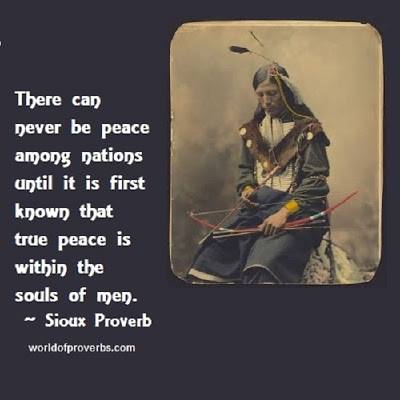You are using an out of date browser. It may not display this or other websites correctly.
You should upgrade or use an alternative browser.
You should upgrade or use an alternative browser.
Native American Heritage Month
- Thread starter just me
- Start date
More options
Who Replied?invisible
On Holiday
- MBTI
- none
Wow, it is so cool to read about the descent of members on the forum.
I am very "white", descended almost completely from Welsh, Scottish, and Irish people, with just one Spanish ancestress. I've always questioned my belonging in the country where I live, which was invaded, violated, and stolen by my ancestors. I consider myself to be a guest of the owners of this country and have often considered returning to the islands where I more properly belong.
Right now is an exciting time for Indigenous affairs in this country, with great potential for change, and I am working towards being a part of it if I can be of service in a long term committed way. I have got a short term opportunity to contribute something meaningful in my near future and I will do my best with it.
My mother experienced a spiritual connection with an Indigenous artist of my country, who created a Sacred Painting for her. In the words of the Mystery Tradition that is a small part of the legacy that I have access to, the painting is a "magic spell" that is to "protect" my mother. The Painting has a place of honour in our house and we can't express our gratitude for it. We love this country where we live and we are so thankful to be a part of it.
I am very "white", descended almost completely from Welsh, Scottish, and Irish people, with just one Spanish ancestress. I've always questioned my belonging in the country where I live, which was invaded, violated, and stolen by my ancestors. I consider myself to be a guest of the owners of this country and have often considered returning to the islands where I more properly belong.
Right now is an exciting time for Indigenous affairs in this country, with great potential for change, and I am working towards being a part of it if I can be of service in a long term committed way. I have got a short term opportunity to contribute something meaningful in my near future and I will do my best with it.
My mother experienced a spiritual connection with an Indigenous artist of my country, who created a Sacred Painting for her. In the words of the Mystery Tradition that is a small part of the legacy that I have access to, the painting is a "magic spell" that is to "protect" my mother. The Painting has a place of honour in our house and we can't express our gratitude for it. We love this country where we live and we are so thankful to be a part of it.
just me
Well-known member
- MBTI
- infj
The last Patuxet
See also: Squanto
Some European expedition captains were known to increase profits by capturing natives to sell as slaves. Such was the case when Thomas Hunt kidnapped several Wampanoag in 1614 in order to sell them later in Spain.
One of his captives, a Patuxet named Tisquantum, anglicized as Squanto, was purchased by Spanish friars; they freed him and instructed him in the Christian faith. After he gained his freedom, Squanto was able to work his way to England where he lived for several years, working with a shipbuilder.
He signed on as an interpreter for a British expedition to Newfoundland. From there Squanto went back to his home, only to discover that, in his absence, epidemics had killed everyone in his village.[SUP][2][/SUP]
Squanto succumbed to "Indian fever" in November 1622.[SUP][9][/SUP] With his death, the Patuxet people passed into history.
Slavery in America began when the first African slaves were brought to the North American colony of Jamestown, Virginia, in 1619, to aid in the production of such lucrative crops as tobacco. The History Channel....proven wrong
See also: Squanto
Some European expedition captains were known to increase profits by capturing natives to sell as slaves. Such was the case when Thomas Hunt kidnapped several Wampanoag in 1614 in order to sell them later in Spain.
One of his captives, a Patuxet named Tisquantum, anglicized as Squanto, was purchased by Spanish friars; they freed him and instructed him in the Christian faith. After he gained his freedom, Squanto was able to work his way to England where he lived for several years, working with a shipbuilder.
He signed on as an interpreter for a British expedition to Newfoundland. From there Squanto went back to his home, only to discover that, in his absence, epidemics had killed everyone in his village.[SUP][2][/SUP]
Squanto succumbed to "Indian fever" in November 1622.[SUP][9][/SUP] With his death, the Patuxet people passed into history.
[*=center]
[*=center]
[*=center]
Slavery in America began when the first African slaves were brought to the North American colony of Jamestown, Virginia, in 1619, to aid in the production of such lucrative crops as tobacco. The History Channel....proven wrong
Last edited:
- MBTI
- INTJ - A
- Enneagram
- 10000
[MENTION=680]just me[/MENTION] Native American Heritage Month: does it just have to be about the negative?
If I were in N America - and inclined to observe it - I'd be learning some Native American skills: bow & arrow making; how to pitch a native tent; fishing techniques (perhaps some songs/crafts), lighting a fire without matches/lighters/modern flints - and actually go out camping with as few modern/western conveniences as possible (ie. no horses, steel knives, etc. either). Get a feel for their trad. life.
If I were in N America - and inclined to observe it - I'd be learning some Native American skills: bow & arrow making; how to pitch a native tent; fishing techniques (perhaps some songs/crafts), lighting a fire without matches/lighters/modern flints - and actually go out camping with as few modern/western conveniences as possible (ie. no horses, steel knives, etc. either). Get a feel for their trad. life.
just me
Well-known member
- MBTI
- infj
This is not all about the negative. I have taken deer with bow and arrow, fished with line tied to a stick and safety pin, lived completely off the land while camping, been to Rock Mountain, and studied them more than most. The negativity comes with so few of them left to observe anything. Most folk don't give them any mind. This thread was in their remembrance. I don't see anything on television.
just me
Well-known member
- MBTI
- infj
[TABLE="width: 1000"]
[TR]
[TD]
[/TR]
[/TABLE]
[TR]
[TD]
[TABLE="width: 975"]
[TR]
[TD="width: 110"][/TD]
[TD="width: 755"]Tree Symbols
[/TD]
[TD="width: 110"]
[/TR]
[/TABLE]
[/TD][TR]
[TD="width: 110"][/TD]
[TD="width: 755"]Tree Symbols
[/TD]
[TD="width: 110"]
[TABLE="width: 100"]
[TR]
[TD][/TD]
[/TR]
[/TABLE]
[/TD][TR]
[TD][/TD]
[/TR]
[/TABLE]
[/TR]
[/TABLE]
[/TR]
[/TABLE]
[TABLE="width: 1000"]
[TR]
[TD]
[/TR]
[/TABLE]
[TR]
[TD]
[TABLE="width: 975"]
[TR]
[TD="width: 500"]
 Tree Symbols - Oak Tree [/TD]
Tree Symbols - Oak Tree [/TD]
[TD]Discover facts and information about the Tree Symbols of the North American Native Indians. Tree symbolism is the representation or meaning of something that is usually specific to a particular culture or society.
Gain an insight into the Tree Symbols of the Native American Indians.
Understand the significance of the 'Standing People' and the use of trees and the knowledge of tree symbols in the culture of Native Americans.[/TD]
[/TR]
[TR]
[TD="align: center"]Native American Symbols[/TD]
[/TR]
[TR]
[TD="align: center"]Native Indian Tribes Index[/TD]
[/TR]
[/TABLE]
[/TD][TR]
[TD="width: 500"]
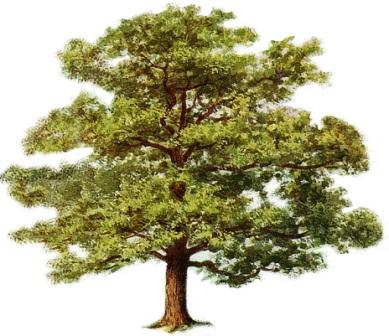
[TD]Discover facts and information about the Tree Symbols of the North American Native Indians. Tree symbolism is the representation or meaning of something that is usually specific to a particular culture or society.
Gain an insight into the Tree Symbols of the Native American Indians.
Understand the significance of the 'Standing People' and the use of trees and the knowledge of tree symbols in the culture of Native Americans.[/TD]
[/TR]
[TR]
[TD="align: center"]Native American Symbols[/TD]
[/TR]
[TR]
[TD="align: center"]Native Indian Tribes Index[/TD]
[/TR]
[/TABLE]
[/TR]
[/TABLE]
[TABLE="width: 1000"]
[TR]
[TD][/TD]
[/TR]
[/TABLE]
[TABLE="width: 975"]
[TR]
[TD="width: 975"][/TD]
[/TR]
[/TABLE]
[TR]
[TD][/TD]
[/TR]
[/TABLE]
[TABLE="width: 975"]
[TR]
[TD="width: 975"][/TD]
[/TR]
[/TABLE]
[TABLE="width: 1000"]
[TR]
[TD][/TD]
[/TR]
[/TABLE]
[TABLE="width: 1000"]
[TR]
[TD]
[TR]
[TD][TABLE="width: 1000"]
[TR]
[TD]
[/TR]
[/TABLE]
[/TR]
[/TABLE]
[/TD]
[/TR]
[/TABLE]
Please forgive the use of "Indian" in this article.
[TR]
[TD][/TD]
[/TR]
[/TABLE]
[TABLE="width: 1000"]
[TR]
[TD]
[TABLE="width: 1000"]
[TR]
[TD]
[/TR]
[/TABLE]
[TABLE="width: 1000"]
[TR]
[TD][/TD]
[/TR]
[/TABLE]
[TABLE="width: 1000"]
[TR]
[TD]
[/TR]
[/TABLE]
[TABLE="width: 1000"]
[TR]
[TD][/TD]
[/TR]
[/TABLE]
[TABLE="width: 1000"][TR]
[TD]
[TABLE="width: 975"]
[TR]
[TD="width: 975"]Tree Symbols
The Cherokee call trees the Standing People and teach that all of their plant relations are the givers of the Earth providing for the needs of others. Each tree has its properties and attributes with the ability to share these with the people - tree symbols. Trees provide healing medicines, shelter from their branches, a place for burrows for the small animals and provide materials to build homes. A Tree symbolizes permanence, longevity and its firm base symbolises the concept of ‘roots’ and an ongoing relationship with natural surroundings. Such positive characteristics and attributes of trees lend themselves to being revered.
Tree Symbols - Prayer and Talking Sticks
The people of many Native American tribes believe that the qualities of each type of tree brings specific medicine and carries a sacred spark of the Great Spirit. The wood from trees was used to create many sacred items including Talking Sticks and Prayer Sticks. The choice of tree and the wood used to make these sacred objects was highly symbolic and had meaning and relevance to the craftsman. Each type of stick was prepared with due respect and ceremony. The wood was carefully chosen for its strength and spirituality and taken from a tree that had special meaning to the person. Permission was sought from the tree spirit to make the talking stick and the prayer stick.
Native American Tree Symbols Chart
The following chart provides details of each tree together with its meanings and symbolism.
[/TR]
[TR]
[TD="width: 975"][/TD]
[/TR]
[/TABLE]
[/TD][TR]
[TD="width: 975"]Tree Symbols
The Cherokee call trees the Standing People and teach that all of their plant relations are the givers of the Earth providing for the needs of others. Each tree has its properties and attributes with the ability to share these with the people - tree symbols. Trees provide healing medicines, shelter from their branches, a place for burrows for the small animals and provide materials to build homes. A Tree symbolizes permanence, longevity and its firm base symbolises the concept of ‘roots’ and an ongoing relationship with natural surroundings. Such positive characteristics and attributes of trees lend themselves to being revered.
Tree Symbols - Prayer and Talking Sticks
The people of many Native American tribes believe that the qualities of each type of tree brings specific medicine and carries a sacred spark of the Great Spirit. The wood from trees was used to create many sacred items including Talking Sticks and Prayer Sticks. The choice of tree and the wood used to make these sacred objects was highly symbolic and had meaning and relevance to the craftsman. Each type of stick was prepared with due respect and ceremony. The wood was carefully chosen for its strength and spirituality and taken from a tree that had special meaning to the person. Permission was sought from the tree spirit to make the talking stick and the prayer stick.
Native American Tree Symbols Chart
The following chart provides details of each tree together with its meanings and symbolism.
[TABLE="width: 759"]
[TR]
[TD="bgcolor: #D3492F, colspan: 2"]
[/TR]
[TR]
[TD="width: 204, bgcolor: #333333, align: center"]
Names of Trees[/TD]
[TD="width: 547, bgcolor: #333333, align: center"]
Tree Symbolism
[/TD]
[/TR]
[TR]
[TD="width: 204, align: center"]
Tree Symbols:
Ash
[/TD]
[TD="width: 547, align: center"]The ash symbolizes peace of mind, sacrifice, sensitivity
and higher awareness[/TD]
[/TR]
[TR]
[TD="width: 204, align: center"]
Tree Symbols:
Aspen
[/TD]
[TD="width: 547, align: center"]The Aspen symbolizes clarity of purpose, determination and overcoming fears and doubts[/TD]
[/TR]
[TR]
[TD="width: 204, align: center"]
Tree Symbols:
Arbutus
[/TD]
[TD="width: 547, align: center"]The sacred Arbutus symbolizes knowledge[/TD]
[/TR]
[TR]
[TD="width: 204, align: center"]
Tree Symbols:
Beech
[/TD]
[TD="width: 547, align: center"]The Beech symbolizes tolerance, past knowledge and
softening criticism[/TD]
[/TR]
[TR]
[TD="width: 204, align: center"]
Tree Symbols:
Birch
[/TD]
[TD="width: 547, align: center"]The Birch symbolizes truth, new beginnings
and cleansing of the past[/TD]
[/TR]
[TR]
[TD="width: 204, align: center"]
Tree Symbols:
Cedar
[/TD]
[TD="width: 547, align: center"]The Cedar symbolizes cleansing, protection, prosperity & healing[/TD]
[/TR]
[TR]
[TD="width: 204, align: center"]
Tree Symbols:
Cherry
[/TD]
[TD="width: 547, align: center"]The Cherry tree symbolizes strong expression, rebirth, new awakenings and compassion[/TD]
[/TR]
[TR]
[TD="width: 204, align: center"]
Tree Symbols:
Elm
[/TD]
[TD="width: 547, align: center"]The Elm symbolizes wisdom, strength of will and intuition[/TD]
[/TR]
[TR]
[TD="width: 204, align: center"]
Tree Symbols:
Maple
[/TD]
[TD="width: 547, align: center"]The Maple symbolizes the tree of offering, generosity, balance, promise and practicality[/TD]
[/TR]
[TR]
[TD="width: 204, align: center"]
Tree Symbols:
Oak
[/TD]
[TD="width: 547, align: center"]The oak symbolizes strength of character and courage[/TD]
[/TR]
[TR]
[TD="width: 204, align: center"]
Tree Symbols:
Pine
[/TD]
[TD="width: 547, align: center"]The pine tree symbolizes creativity, peace and harmony[/TD]
[/TR]
[TR]
[TD="width: 204, align: center"]
Tree Symbols:
Sycamore
[/TD]
[TD="width: 547, align: center"]
Sycamore symbolizes ambition
[/TD]
[/TR]
[TR]
[TD="width: 204, align: center"]
Tree Symbols:
Willow
[/TD]
[TD="width: 547, align: center"]The willow symbolizes inner wisdom, an open mind with the stability and strength of age and experience.[/TD]
[/TR]
[TR]
[TD="width: 204, align: center"]
Tree Symbols:
Walnut
[/TD]
[TD="width: 547, align: center"]The Walnut symbolizes clarity and focus, gathering of energy and beginning new projects[/TD]
[/TR]
[TR]
[TD="width: 204, align: center"]
Tree Symbols:
White Pine
[/TD]
[TD="width: 547, align: center"]The White Pine symbolizes serenity[/TD]
[/TR]
[TR]
[TD="width: 751, colspan: 2, align: center"]
 [/TD]
[/TD]
[/TR]
[TR]
[TD="bgcolor: #D3492F, colspan: 2"]
[/TR]
[/TABLE]
[/TD][TR]
[TD="bgcolor: #D3492F, colspan: 2"]
Native American Tree Symbols Chart
[/TD][/TR]
[TR]
[TD="width: 204, bgcolor: #333333, align: center"]
Names of Trees[/TD]
[TD="width: 547, bgcolor: #333333, align: center"]
Tree Symbolism
[/TD]
[/TR]
[TR]
[TD="width: 204, align: center"]
Tree Symbols:
Ash
[/TD]
[TD="width: 547, align: center"]The ash symbolizes peace of mind, sacrifice, sensitivity
and higher awareness[/TD]
[/TR]
[TR]
[TD="width: 204, align: center"]
Tree Symbols:
Aspen
[/TD]
[TD="width: 547, align: center"]The Aspen symbolizes clarity of purpose, determination and overcoming fears and doubts[/TD]
[/TR]
[TR]
[TD="width: 204, align: center"]
Tree Symbols:
Arbutus
[/TD]
[TD="width: 547, align: center"]The sacred Arbutus symbolizes knowledge[/TD]
[/TR]
[TR]
[TD="width: 204, align: center"]
Tree Symbols:
Beech
[/TD]
[TD="width: 547, align: center"]The Beech symbolizes tolerance, past knowledge and
softening criticism[/TD]
[/TR]
[TR]
[TD="width: 204, align: center"]
Tree Symbols:
Birch
[/TD]
[TD="width: 547, align: center"]The Birch symbolizes truth, new beginnings
and cleansing of the past[/TD]
[/TR]
[TR]
[TD="width: 204, align: center"]
Tree Symbols:
Cedar
[/TD]
[TD="width: 547, align: center"]The Cedar symbolizes cleansing, protection, prosperity & healing[/TD]
[/TR]
[TR]
[TD="width: 204, align: center"]
Tree Symbols:
Cherry
[/TD]
[TD="width: 547, align: center"]The Cherry tree symbolizes strong expression, rebirth, new awakenings and compassion[/TD]
[/TR]
[TR]
[TD="width: 204, align: center"]
Tree Symbols:
Elm
[/TD]
[TD="width: 547, align: center"]The Elm symbolizes wisdom, strength of will and intuition[/TD]
[/TR]
[TR]
[TD="width: 204, align: center"]
Tree Symbols:
Maple
[/TD]
[TD="width: 547, align: center"]The Maple symbolizes the tree of offering, generosity, balance, promise and practicality[/TD]
[/TR]
[TR]
[TD="width: 204, align: center"]
Tree Symbols:
Oak
[/TD]
[TD="width: 547, align: center"]The oak symbolizes strength of character and courage[/TD]
[/TR]
[TR]
[TD="width: 204, align: center"]
Tree Symbols:
Pine
[/TD]
[TD="width: 547, align: center"]The pine tree symbolizes creativity, peace and harmony[/TD]
[/TR]
[TR]
[TD="width: 204, align: center"]
Tree Symbols:
Sycamore
[/TD]
[TD="width: 547, align: center"]
Sycamore symbolizes ambition
[/TD]
[/TR]
[TR]
[TD="width: 204, align: center"]
Tree Symbols:
Willow
[/TD]
[TD="width: 547, align: center"]The willow symbolizes inner wisdom, an open mind with the stability and strength of age and experience.[/TD]
[/TR]
[TR]
[TD="width: 204, align: center"]
Tree Symbols:
Walnut
[/TD]
[TD="width: 547, align: center"]The Walnut symbolizes clarity and focus, gathering of energy and beginning new projects[/TD]
[/TR]
[TR]
[TD="width: 204, align: center"]
Tree Symbols:
White Pine
[/TD]
[TD="width: 547, align: center"]The White Pine symbolizes serenity[/TD]
[/TR]
[TR]
[TD="width: 751, colspan: 2, align: center"]
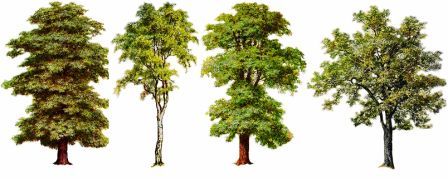
[/TR]
[TR]
[TD="bgcolor: #D3492F, colspan: 2"]
Native American Tree Symbols Chart
[/TD][/TR]
[/TABLE]
[/TR]
[TR]
[TD="width: 975"][/TD]
[/TR]
[/TABLE]
[/TR]
[/TABLE]
[TABLE="width: 1000"]
[TR]
[TD][/TD]
[/TR]
[/TABLE]
[TABLE="width: 1000"]
[TR]
[TD]
[TABLE="width: 990"]
[TR]
[TD="width: 330"]
[TD="width: 330"]
 [/TD]
[/TD]
[TD="width: 330"]
[/TR]
[/TABLE]
[/TD][TR]
[TD="width: 330"]
[TABLE="width: 304"]
[TR]
[TD][/TD]
[/TR]
[/TABLE]
[/TD][TR]
[TD][/TD]
[/TR]
[/TABLE]
[TD="width: 330"]
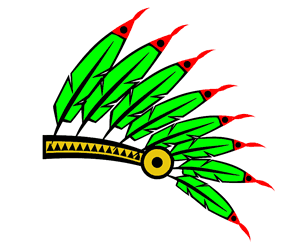
[TD="width: 330"]
[TABLE="width: 304"]
[TR]
[TD][/TD]
[/TR]
[/TABLE]
[/TD][TR]
[TD][/TD]
[/TR]
[/TABLE]
[/TR]
[/TABLE]
[/TR]
[/TABLE]
[TABLE="width: 1000"]
[TR]
[TD][/TD]
[/TR]
[/TABLE]
[TR]
[TD][TABLE="width: 1000"]
[TR]
[TD]
[TABLE="width: 975"]
[TR]
[TD="width: 975"]Tree Symbols - The Cedar Tree
The ancient Mississippian Mound Builders believed that the universe consisted of three parts with good and bad spiritual forces. These three worlds were linked together and their connection was usually portrayed as a cedar tree.
Tree Symbols - The Tree of Peace
The Iroquois had two great leaders Dekanawida, the Great Peacemaker and Hiawatha who united the 5 nations to create the Iroquois Confederacy. The Great Peacemaker used a white pine, called the Tree of Peace, to symbolize the peace and friendship that had been established by creating the confederacy. The branches of the Tree of Peace represented protection. A far seeing eagle sat upon the top of the tree to symbolizing a warning system between the tribes and beneath the roots of the Tree of Peace a weapon was buried. This symbolic act meant that there would be no fighting between the Iroquois tribes.
 Tree of Peace and Protection[/TD]
Tree of Peace and Protection[/TD]
[/TR]
[/TABLE]
[/TD][TR]
[TD="width: 975"]Tree Symbols - The Cedar Tree
The ancient Mississippian Mound Builders believed that the universe consisted of three parts with good and bad spiritual forces. These three worlds were linked together and their connection was usually portrayed as a cedar tree.
Tree Symbols - The Tree of Peace
The Iroquois had two great leaders Dekanawida, the Great Peacemaker and Hiawatha who united the 5 nations to create the Iroquois Confederacy. The Great Peacemaker used a white pine, called the Tree of Peace, to symbolize the peace and friendship that had been established by creating the confederacy. The branches of the Tree of Peace represented protection. A far seeing eagle sat upon the top of the tree to symbolizing a warning system between the tribes and beneath the roots of the Tree of Peace a weapon was buried. This symbolic act meant that there would be no fighting between the Iroquois tribes.
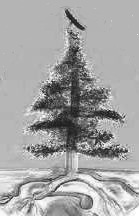
[/TR]
[/TABLE]
[/TR]
[/TABLE]
[TABLE="width: 1000"]
[TR]
[TD][/TD]
[/TR]
[/TABLE]
[/TD][TR]
[TD][/TD]
[/TR]
[/TABLE]
[/TR]
[/TABLE]
[/TD]
[/TR]
[/TABLE]
Please forgive the use of "Indian" in this article.
just me
Well-known member
- MBTI
- infj
"The Great Spirit" is the English translation of the name of the creator god in many Native American traditions, particularly Algonquian and Siouan tribes. Since Algonquian tribes were the first Native American cultures encountered by English speakers, "Great Spirit" became a common term referring to Native American creator deities in general, and was also frequently used as the word for "God" in translations of Christian texts into Native American languages. Indeed, many Native American people consider the Great Spirit and the Christian God to be one and the same. Other Native American people are less receptive to this idea, believing that today's notion of the Great Spirit was mostly constructed by missionaries. The truth is probably somewhere in the middle-- many Native American tribal traditions definitely did include some form of Great Spirit in their creation myths and religious rituals, but some tribes never had such traditions until after colonization. And in other tribes, while there had always been the belief in a Great Spirit or Great Mystery that provided order to the spiritual world, this belief system became significantly altered after contact with Christianity and modern conceptions of the Native American Great Spirit may not be a very accurate representation of the original Native spirituality.Native American Names For The Great Spirit
Above Old Man (Wiyot Indian Great Spirit)
Apistotoke (Blackfoot Great Spirit)
Caddi-Ayo (Caddo Great Spirit)
Chebbeniathan (Arapaho Great Spirit)
Gici Niwaskw (Abenaki Great Spirit)
Gitchi Manitou (Ojibwe Great Spirit)
Ha-Wen-Neyu (Huron Indian Great Spirit)
Kisulkw (Micmac Indian Great Spirit)
Ketanitowet (Lenape Indian Great Spirit)
Maheo (Cheyenne Indian Great Spirit)
Orenda (Iroquois Indian Great Spirit)
Sky-Chief (Carib Indian Great Spirit)
Spider of Heaven (Gros Ventre Great Spirit)
Tirawa Atius (Pawnee Indian Great Spirit)
Utakke (Carrier Great Spirit)
Wakantanka (Sioux Indian Great Spirit)
Wakondo (Omaha Indian Great Spirit)
Above Old Man (Wiyot Indian Great Spirit)
Apistotoke (Blackfoot Great Spirit)
Caddi-Ayo (Caddo Great Spirit)
Chebbeniathan (Arapaho Great Spirit)
Gici Niwaskw (Abenaki Great Spirit)
Gitchi Manitou (Ojibwe Great Spirit)
Ha-Wen-Neyu (Huron Indian Great Spirit)
Kisulkw (Micmac Indian Great Spirit)
Ketanitowet (Lenape Indian Great Spirit)
Maheo (Cheyenne Indian Great Spirit)
Orenda (Iroquois Indian Great Spirit)
Sky-Chief (Carib Indian Great Spirit)
Spider of Heaven (Gros Ventre Great Spirit)
Tirawa Atius (Pawnee Indian Great Spirit)
Utakke (Carrier Great Spirit)
Wakantanka (Sioux Indian Great Spirit)
Wakondo (Omaha Indian Great Spirit)
Last edited:
Wolfskillian
Banned
- MBTI
- IxFJ
- Enneagram
- Eh?
Looks like I joined the community before I could post something on this. Yea, I knew Nov. was the month in which we celebrate their remembrance. But more than that, being a military man, we also celebrate the memory of The Wind Talkers. I heard the last one just turned 103 or something like that. I need to find that link... when I do, I'll post it here. Great thread, and a great part of our history that shouldn't be forgotten.
Artisan
Dares, Dreams, Does
- MBTI
- INFJ-A
- Enneagram
- 1w2
Looks like I joined the community before I could post something on this. Yea, I knew Nov. was the month in which we celebrate their remembrance. But more than that, being a military man, we also celebrate the memory of The Wind Talkers. I heard the last one just turned 103 or something like that. I need to find that link... when I do, I'll post it here. Great thread, and a great part of our history that shouldn't be forgotten.
The sad thing is, I'm a European, and I'm probably one of the few on the forum who actually know who The Wind Talkers were x)
Not the individuals by name ofc. just which group of individuals this refers to and what they did.
Wolfskillian
Banned
- MBTI
- IxFJ
- Enneagram
- Eh?
The sad thing is, I'm a European, and I'm probably one of the few on the forum who actually know who The Wind Talkers were x)
Not the individuals by name ofc. just which group of individuals this refers to and what they did.
Agreed, that is sad.
sprinkles
Well-known member
- MBTI
- xxxx
The sad thing is, I'm a European, and I'm probably one of the few on the forum who actually know who The Wind Talkers were x)
Not the individuals by name ofc. just which group of individuals this refers to and what they did.
Wasn't there a movie about that?
Artisan
Dares, Dreams, Does
- MBTI
- INFJ-A
- Enneagram
- 1w2
Wasn't there a movie about that?
yes! with Nicolas Cage
- MBTI
- INFJ
- Enneagram
- 295ish
My Father was a radio man in WWII.
Mine was a skinny and scared 17 year old grunt when he landed on Omaha Beach. Here's to The Wind Talkers, our fathers, and all the men and women that followed in their footsteps.
:tea:


